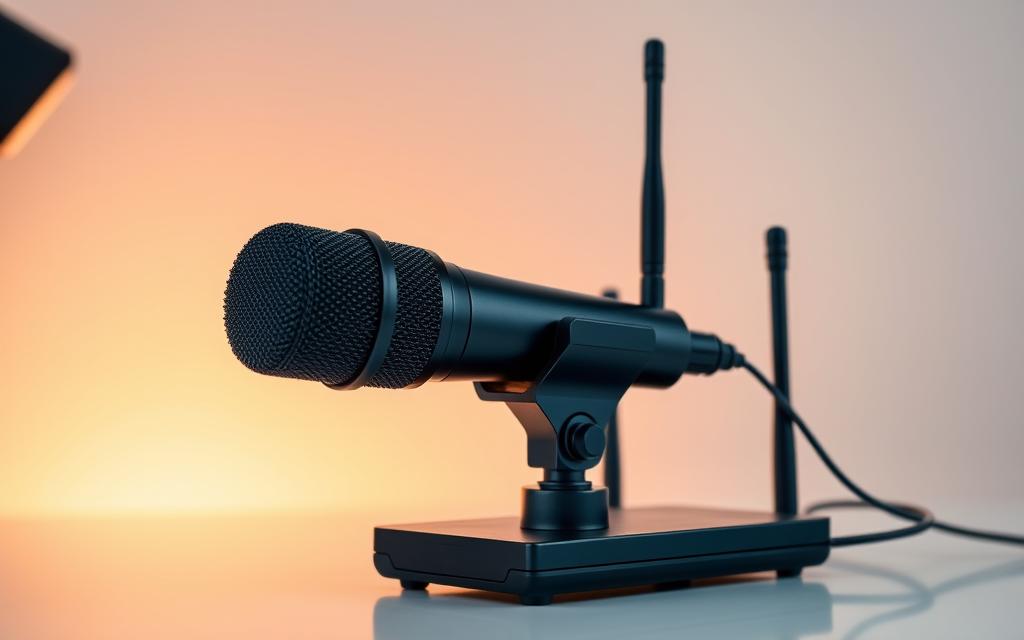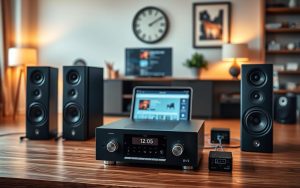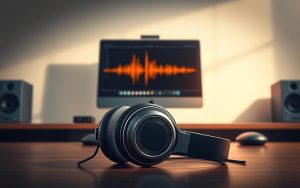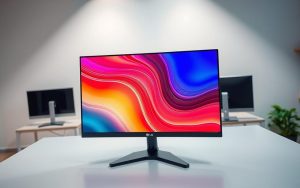Table of Contents
Professional audio quality is now a must for live streaming and content creation. Viewers expect crisp, clear sound without background noise. A wireless microphone offers flexibility and superior noise isolation compared to built-in or USB mics.
Dynamic models like the Phenyx Pro PTU analog system deliver reliable performance. Digital options, such as PDP setups, provide even better signal clarity. However, converting analog signals to digital without quality loss can be tricky.
Using an audio interface or USB mixer ensures optimal sound for your live streaming sessions. These tools bridge the gap between your mic and computer, preserving audio fidelity. The right setup makes all the difference in professional-grade broadcasts.
What You Need to Connect a Wireless Mic to Your Computer for Live Feed
High-quality sound starts with the right equipment. Whether you’re streaming podcasts or gaming sessions, a solid setup ensures crystal-clear audio. Below, we break down the must-have components.
Core Hardware Components
A wireless microphone system requires these key pieces:
- Receiver: Captures the mic’s signal and transmits it to your computer.
- Audio Interface/USB Mixer: Devices like the Phenyx Pro PTX-15 or Focusrite Scarlett 2i2 enhance signal quality.
- Cables: TRS/TRRS cables connect the receiver to your interface or laptop.
Dedicated interfaces outperform basic adapters for audio clarity. For example, TRRS adapters often introduce noise, while interfaces like the Scarlett 2i2 maintain fidelity.
| Device | Best For | Key Features |
|---|---|---|
| Phenyx Pro PTX-15 | Live streaming | 4 inputs, 16 DSP effects, USB/Bluetooth |
| Focusrite Scarlett 2i2 | Studio recording | Multitrack DAW support, low-latency |
Software and Compatibility
Your system needs software to process audio. Popular options include:
- OBS Studio: Ideal for live streaming with customizable audio settings.
- Audacity: A free DAW for recording and editing.
Always check OS compatibility. Most interfaces work seamlessly with Windows and macOS. Mic-level inputs suit dynamic mics, while line-level handles stronger signals.
With the right hardware and software, your broadcasts will sound professional every time.
Step-by-Step Guide: How to Connect Wireless Mic to Computer for Live Feed
Streaming with professional audio starts with seamless connections. Follow these steps to integrate your microphone system with a computer for lag-free broadcasts.
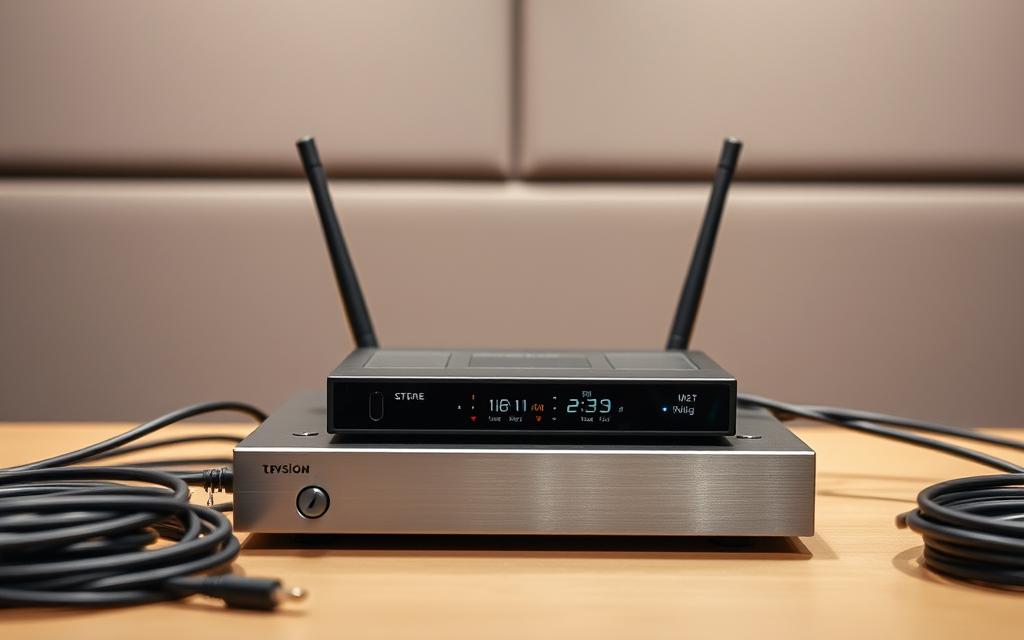
Pairing the Transmitter and Receiver
First, sync your mic’s transmitter with the receiver. For models like the RØDE Wireless GO II:
- Power both devices and set them to the same frequency.
- Enable auto-pairing if available, or manually match channels.
Check the receiver’s LED indicators for confirmation. A solid light signals successful pairing.
Linking the Receiver to Your PC
Next, connect the receiver to your computer:
- USB-C: Plug the RØDE GO II directly into a port for digital signal transfer.
- XLR/TRS: Use cables to link analog receivers to an audio interface like the Scarlett 2i2.
| Connection Type | Best For | Setup Time |
|---|---|---|
| USB-C (RØDE GO II) | Quick plug-and-play | Under 1 minute |
| XLR + Interface | Studio-grade quality | 3–5 minutes |
Configuring Streaming Software
Finally, assign the audio source in your software:
- Open OBS or Zoom and navigate to audio settings.
- Select your interface or USB mixer as the input device.
- Adjust levels to avoid clipping (aim for –12dB to –6dB).
Test with headphones to ensure zero latency. For USB mixers like the Phenyx Pro PTX-15, assign stereo inputs in your DAW.
Optimizing Audio Quality for Live Streaming
Crisp, distortion-free audio separates amateur streams from professional broadcasts. Fine-tuning your setup ensures every word resonates clearly with viewers. Below, we break down essential adjustments for pristine sound.
Adjusting Microphone Settings in Windows/macOS
Start with your laptop or PC’s native settings:
- Sample rate: Set to 48 kHz in Windows Sound Control Panel for broadcast-standard clarity.
- Exclusive mode: Enable to reduce latency during live sessions.
- Enhancements: Disable audio effects like “echo cancellation” to avoid artificial sound distortion.
For macOS, use Audio MIDI Setup to match your microphone’s input level with streaming software requirements.
Using an Audio Interface or USB Mixer for Enhanced Sound
Hardware like the Phenyx Pro PTX-15 elevates raw audio with:
- 3-band EQ to balance vocal tones.
- Built-in DSP effects (reverb, compression) for polished output.
- USB connectivity for plug-and-play streaming.
Position your microphone 6–12 inches away and use a pop filter to minimize plosives. Compare raw and processed tracks to find the sweet spot for your content.
Troubleshooting Common Wireless Mic Connection Issues
Even the best wireless microphone setups can encounter technical hiccups. From laggy audio to unrecognized devices, these challenges disrupt streaming sessions. Below, we outline proven fixes for seamless performance.
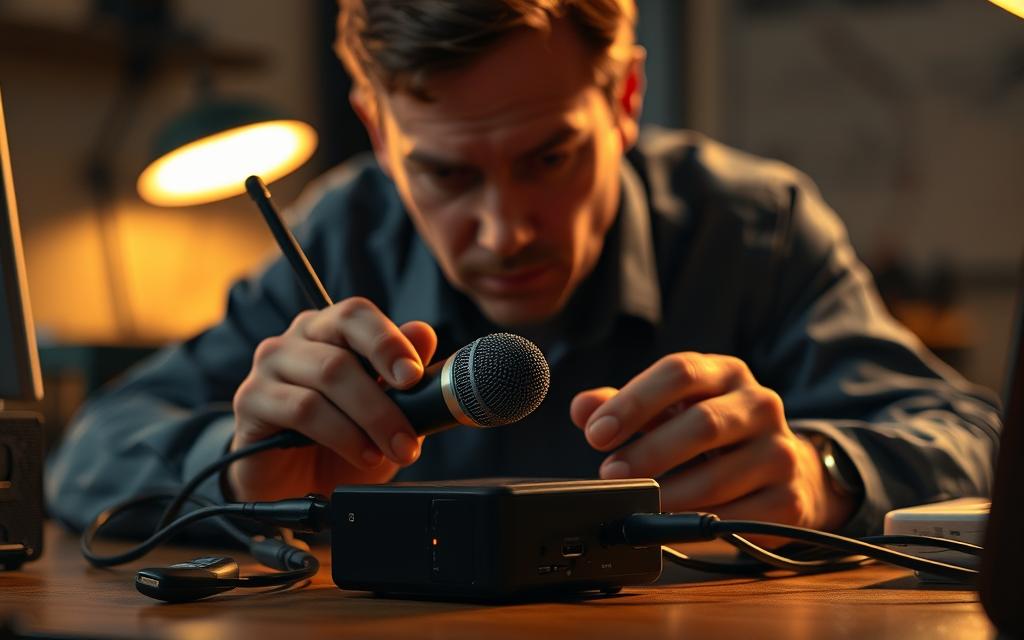
Dealing with Latency or Audio Delay
Latency makes your voice echo in recordings. To diagnose:
- Test audio through an interface’s direct monitoring (zero latency) versus software monitoring.
- Swap virtual audio cables for hardware interfaces like the Scarlett 2i2.
“Ground loop hum? Balanced XLR cables or USB isolators eliminate interference.”
| Issue | Solution | Tool |
|---|---|---|
| Laggy playback | Enable ASIO drivers | Focusrite Control |
| Signal dropouts | Update firmware | Phenyx Pro PTX-15 |
Resolving Driver or Compatibility Problems
If your computer doesn’t detect the mic:
- Reinstall device-specific driver software (e.g., RØDE Central).
- Check USB port power settings or try alternate ports.
For macOS users, reset the Audio MIDI Setup. Windows users should disable exclusive mode in Sound Control Panel if conflicts arise.
Conclusion
Elevating your audio setup transforms streaming quality. Interfaces like the Phenyx Pro PTX-15 bridge the gap between raw input and polished output. They ensure professional-grade clarity for every broadcast.
Invest in adaptable systems. Hybrid setups handle both live streaming and studio recording effortlessly. Test configurations beforehand to avoid last-minute hiccups.
Ready to upgrade? Explore advanced guides or compatible computer peripherals. The right tools make all the difference in delivering crisp, engaging content.
FAQ
What hardware is needed to link a wireless microphone to a PC?
You’ll need a wireless microphone system with a compatible receiver, an audio interface (if using XLR), or a USB connection. Some mics, like the Rode Wireless Go II, plug directly into a USB port.
Does live streaming require special software for audio input?
Yes. Programs like OBS Studio, Streamlabs, or Zoom let you select the microphone as an input source. Ensure drivers are updated for seamless integration.
How do I sync the receiver with my computer?
Plug the receiver into a USB port or audio interface. For XLR connections, use an adapter like the Focusrite Scarlett series. Pair the mic with the receiver following the manufacturer’s instructions.
Why is there latency during live streaming?
Latency often stems from outdated drivers or high buffer settings. Reduce delay by adjusting settings in your streaming software or using ASIO drivers for professional audio interfaces.
Can I improve sound quality without expensive gear?
Yes. Use built-in tools like Windows’ “Enhancements” or macOS’ “Audio MIDI Setup” to fine-tune levels. A budget USB mixer, such as the Behringer Q802USB, can also elevate audio clarity.
What if my PC’s audio input doesn’t recognize the mic?
Check device manager for driver issues. Test the mic on another device to rule out hardware failure. For USB mics, try different ports or reinstall drivers.


